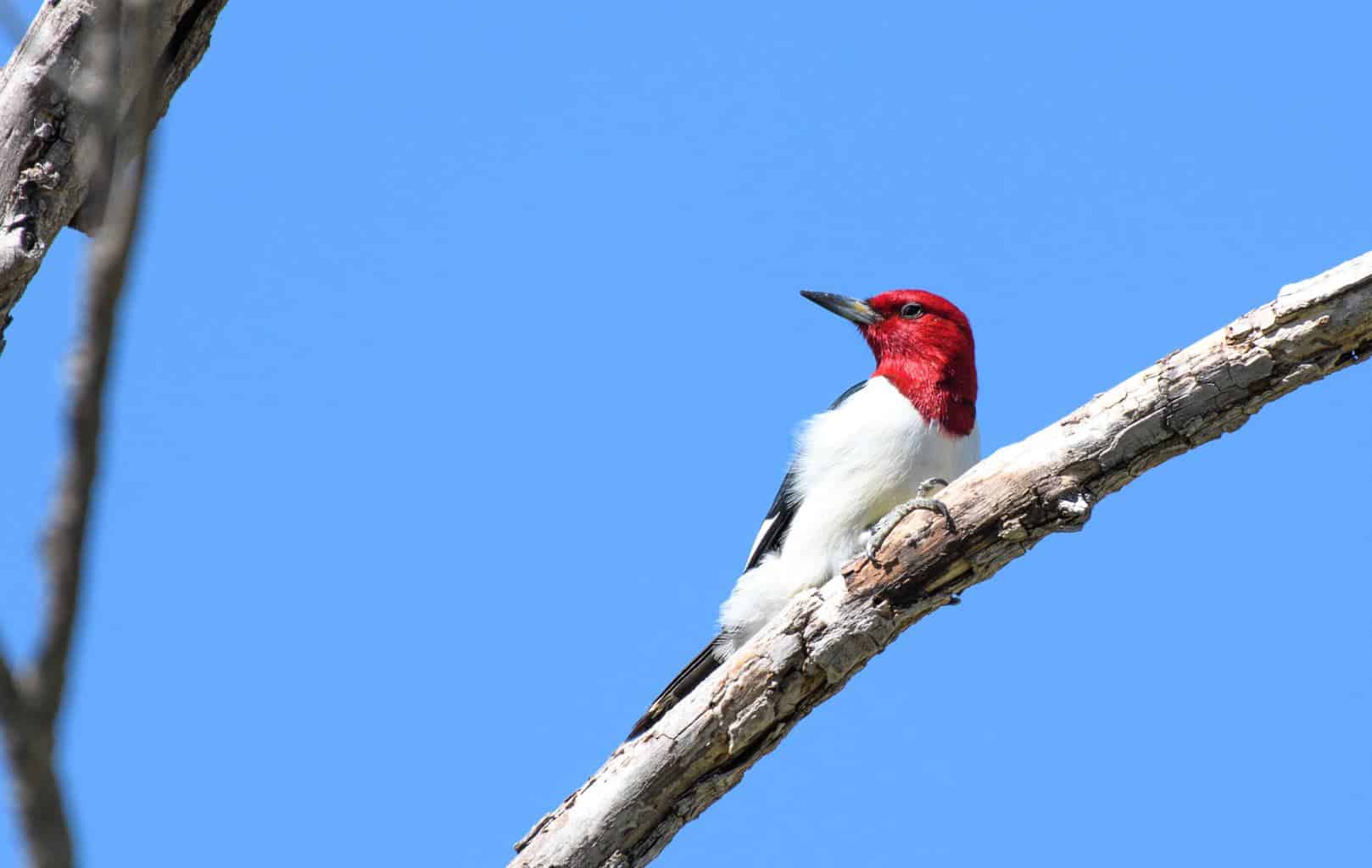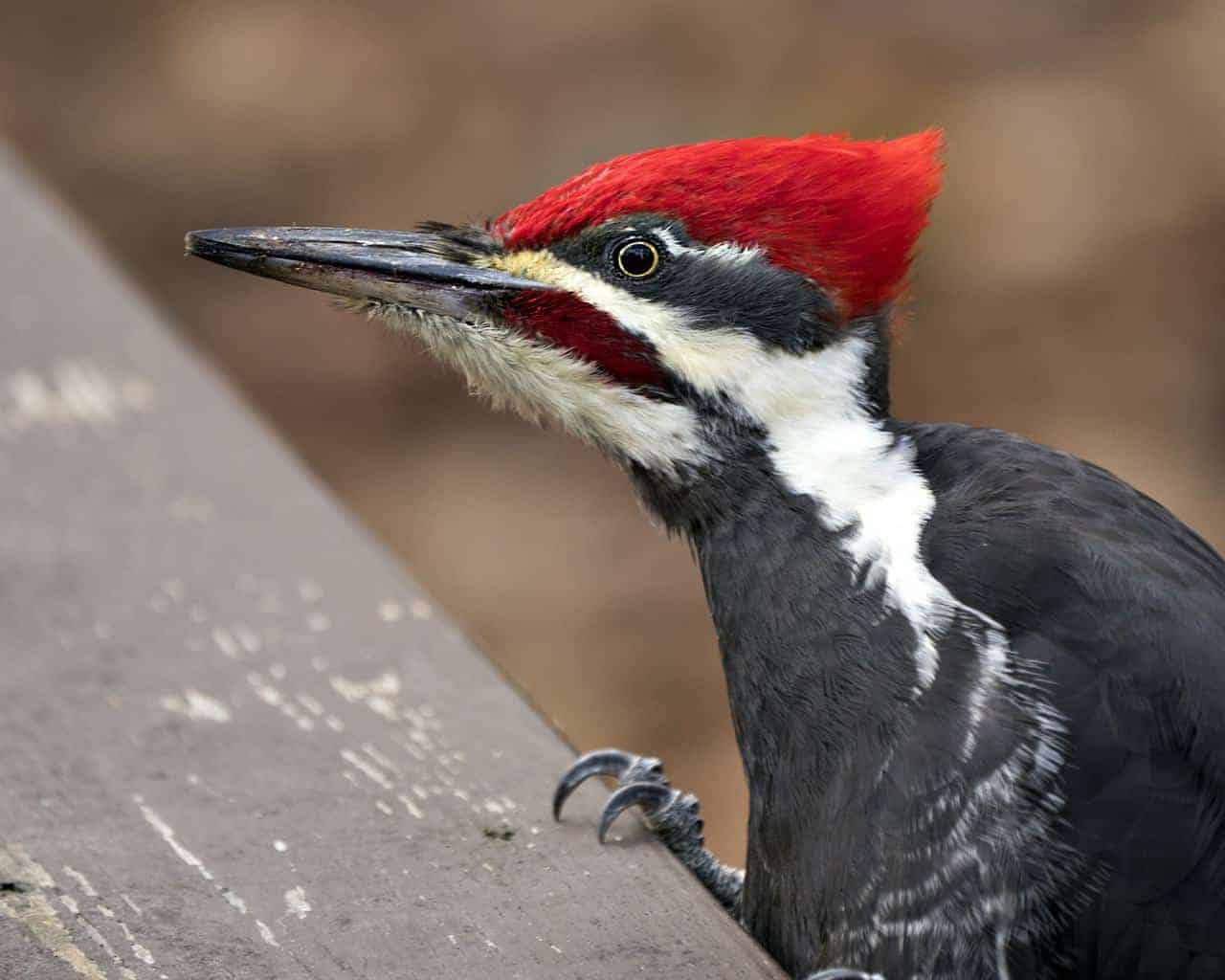According to the Mississippi Ornithological Society, Mississippi is home to over 400 species of birds. Some of those species are all-year residents, while others are mere migrating visitors.
When it comes to woodpeckers, Mississippi’s varied nature makes it suitable for a diverse variety of woodpecker species. From flat open woodlands, pinelands, and savannahs to swamps and river beds, the peckers have inhabited different areas all over the state.
Interested to know where you can find woodpeckers in Mississippi? Look no further; we’ll give you all the information you need to spot one, or possibly all eight species, residing in Mississippi.
Red-Headed Woodpecker

- Scientific Name: Melanerpes erythrocephalus
- Length: 7.5 – 9.1 inches
- Weight: 2.0 – 3.2 ounces
- Wingspan: 6.5 inches
Red-headed woodpeckers are medium-sized with bright crimson heads. Their bodies are white with black backs and tails. As far as their wings are concerned, they’re half-black and half-white, giving them the apt nickname “flying checkerboards.”
They prefer open forests and wetlands, so you can find them in areas like pinelands and swamps. They’re year-round residents of the state of Mississippi, so you can spot them anytime.
These birds are known for their ability to catch insects in flight, not just by pecking. They may also fancy some seeds and fruits from a birdfeeder, so if you have one, they just might find their way to your backyard, especially in the winter months.
Red-Bellied Woodpecker

- Scientific Name: Melanerpes carolinus
- Length: 9.4 inches
- Weight: 2.0 – 3.2 ounces
- Wingspan: 13.0 – 16.5 inches
Contrary to their name, red-bellied woodpeckers have a pale colored belly. Though, sometimes they may have a light red hue, hence the name.
The male adult has a red crown and nape, while the female only has a red nape. Both sexes of this species, however, have striped black and white backs and wings.
Red-bellied woodpeckers are one of the most common resident peckers in Mississippi, and they can be spotted all-year-round. Don’t be surprised if you occasionally see them around suet bird feeders, as they are an urban-friendly bunch. When in the wild, however, they prefer woodlands and forests, and you’ll likely find them perched on medium to large-sized trees, such as oaks or pines.
Yellow-Bellied Sapsucker

- Scientific Name: Sphyrapicus varius
- Length: 7.1 – 8.7 inches
- Weight: 1.5 – 1.9 ounces
- Wingspan: 13.4 – 15.8 inches
Yellow-bellied sapsuckers are a small-sized woodpecker species. They have long black and white stripes running from their face and down their backs and a red forehead; males of the species also feature red-colored necks. Their bellies have a pale yellowish tint.
They migrate to Mississippi during the winter months, starting September and up to May. You’ll usually find them in small trees, yet they prefer spending their winters in open woodlands.
As the name suggests, sapsuckers feed by sucking the sap out of tree bark. They are known to peck on trees in a unique stuttering pattern, making these slurps quite noisy. You can track them by following the sap wells they leave behind in trees.
Downy Woodpecker

- Scientific Name: Dryobates pubescens
- Length: 5.5 – 6.7 inches
- Weight: 0.7 – 1.0 ounces
- Wingspan: 9.8 – 11.8 inches
The downy has a black and white pattern featuring more black than white markings. Their tail is the lightest part of these birds, as it’s white with black spots. The male of the species has a red spot on its crown that is very distinguishable.
This is your friendly backyard woodpecker and one of the most common peckers you’ll spot in Mississippi, even in residential areas. In nature, you’ll find they prefer orchards, woodlands, as well as bushes and weeds.
They have a distinct flight pattern, flying up and down and making a lot of humming and drumming sounds.
Hairy Woodpecker

- Scientific Name: Dryobates villosus
- Length: 7.1 – 10.2 inches
- Weight: 1.4 – 3.4 ounces
- Wingspan: 13.0 – 16.1 inches
The hairy woodpecker has physical features that are so much like the downy woodpecker that they’re relatively hard to tell apart; the similarities are down to the males’ red crown. Perhaps the easiest way to distinguish the two is their bill size, as the hairy woodpecker has a larger one.
You’ll easily find this pecker across Mississippi, especially in areas that have open woodlands, parks, and even cemeteries.
Red-Cockaded Woodpecker

- Scientific Name: Dryobates borealis
- Length: 7.9 – 9.1 inches
- Weight: 1.5 – 1.8 ounces
- Wingspan: 14.2 inches
The red-cockaded woodpecker is mostly black and white with a bar pattern across its back. The male has a faint red stripe, or cockade if you will, on its white cheek. But you have to be close to the bird to spot it!
Sadly, the red-cockaded is endangered due to encroachment on its preferred natural habitats. You used to find them in leafy Pinelands, but that is rarely the case now. But luckily, you can still find them in Mississippi’s DeSoto National Forest.
Northern Flicker

- Scientific Name: Colaptes auratus
- Length: 1.0 – 12.2 inches
- Weight: 3.9 – 5.6 ounces
- Wingspan: 16.5 – 20.1 inches
Compared to other woodpeckers populating Mississippi, the northern flicker is the most distinct in terms of physical appearance. They’re brownish beige with a dark speckled pattern covering their bodies.
The most noticeable attribute of the Mississippi northern flicker is the bright yellow color covering the underside of their wings and tail.
You can find them in woodlands, yards, parks, and other open habitats in Mississippi. Apart from perching on trees, they also like to nest on the ground, a characteristic that distinguishes them from other woodpeckers in the area.
Pileated Woodpecker

- Scientific Name: Dryocopus pileatus
- Length: 15.8 – 19.3 inches
- Weight: 8.8 – 12.3 ounces
- Wingspan: 26.0 – 29.5 inches
If you’re a Woody Woodpecker fan, you’ll immediately recognize this one. Woody was drawn based on the pileated woodpecker and its distinguished red-colored crest. It has a black body that reveals white underwings when in flight.
Despite preferring dead and downed wood, these peckers are highly adaptable and have made homes for themselves in various areas across the state of Mississippi, including forests, parks, and even some residential areas.
Final Thoughts
Observing woodpeckers can be mesmerizing. The repetitive pricking sound, coupled with the rapid motion of pecking, can be a fun experience.
In addition to the eight species we mentioned, keep an eye out for the majestic ivory-billed woodpecker in Mississippi. It has been considered extinct for around 50 years, but a few alleged sightings over the years would beg to differ. So, if you do see one, it’s a pretty huge deal!











